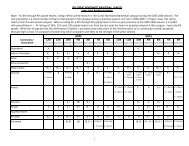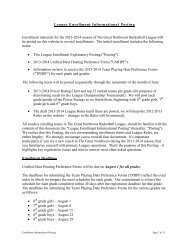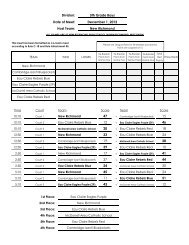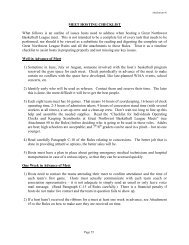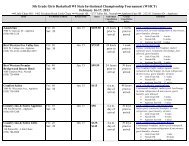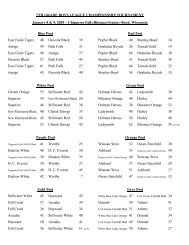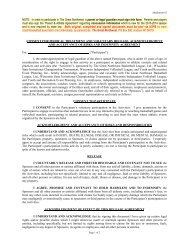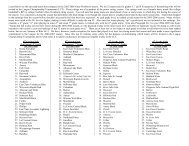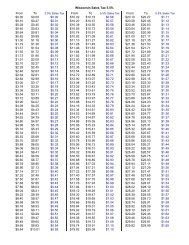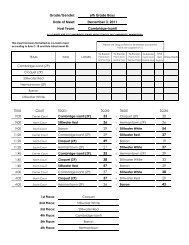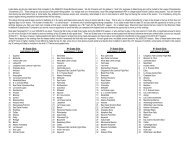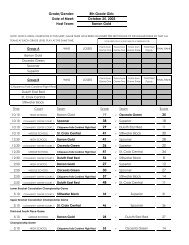THE GREAT NORTHWEST BASKETBALL LEAGUE
THE GREAT NORTHWEST BASKETBALL LEAGUE
THE GREAT NORTHWEST BASKETBALL LEAGUE
You also want an ePaper? Increase the reach of your titles
YUMPU automatically turns print PDFs into web optimized ePapers that Google loves.
2011-2012 Season<br />
GNBL Rules<br />
While "B" teams and geographically-central teams are fairly easy to schedule, the League often<br />
struggles placing teams on our geographic fringe [as well as the very strongest ("A") and weakest<br />
("C") teams] in locations that coaches feel are manageable trips.<br />
The League expects all teams to be able to travel up to 90 minutes on occasion, provided that<br />
their average trip is no more than 60-70 minutes (which means there are 15 or 30 minute trips<br />
mixed in). However, "A" teams, those teams on the League's geographic fringe, those teams that<br />
are in fairly remote locations, and those teams that don't host and aren't part of a program that has<br />
submitted a Unified Meet Hosting Preference Form, will be expected to travel further on<br />
occasion, provided that the average travel time for all their meets doesn't exceed 75 minutes<br />
(again, this means that shorter trips are part of the mix).<br />
8) Who Plays At What Time? For each meet, the teams assigned to the first time slot are those in<br />
the group whose most distant team is closer to the host's location than the most distant team from<br />
the other group. Where the two most distant teams are relatively equidistant from the meet site,<br />
the host team's group will play in the first time slot.<br />
When a host team is hosting two meets on four courts on a given day in the same town, instead<br />
of having half the teams from each of the two meets start at 9:00 a.m., and the other half from<br />
each of the two meets start at 10:10 a.m., the League reserves the option of having all eight teams<br />
from one meet play their first game at 9:00 a.m., and all eight teams from the other meet play<br />
their first game at 10:10 a.m. Some examples of times when this scheduling procedure will not<br />
be followed are: a) if to do so will result in a team with a trip of two hours (or more) having to<br />
play at 9:00 a.m.; or b) if one or more of the courts at the host's facilities is smaller and is not<br />
suitable for use by the older grade being hosted that day.<br />
9) Who Plays Whom. All 8 th , 7 th , and 6 th grade League teams will be rated at one of the following<br />
five levels: "A", "B+", "B", "B-" or "C". A team's rating will be based on a combination of that<br />
team's performance the previous season and the community's or association's current season<br />
perspective on relative ability. Where possible, the League will attempt to keep teams from<br />
playing in a meet where the ratings cover more than three consecutive rating slots. For instance,<br />
"A" and "B+" teams (and occasionally "B" teams) will be scheduled to play in "A" meets. "B+",<br />
"B" and "B-" teams will be scheduled to play in "B" meets. "B-" and "C" teams (and occasionally<br />
"B" teams) will be scheduled to play in "C" meets. The only time that "B+" teams will be<br />
scheduled with "C" teams, or "B-" teams with "A" teams, is if to do otherwise would result in<br />
some teams traveling too great a distance to play in a meet. In those cases, the League will strive<br />
to construct one stronger group and one weaker group, so that, for example, all "B+" and all "C"<br />
or "B-" teams are in opposite groups. "A" teams will never knowingly be scheduled to play in a<br />
meet with "C" teams. Since 4 th and 5 th grade teams do not have ratings from the previous season,<br />
4 th and 5 th grade meets are "open scheduled" (i.e., not seeded).<br />
10) Tie Breakers. When The Great Northwest was established 17 years ago, almost all meets had<br />
eight teams playing in two pools of four. Since then, we have established the use of six-team<br />
meets to facilitate hosting for communities with three or five available courts. Also, as the<br />
League has grown, there are more seven-team meets where an opening in an eight-team meet<br />
goes unfilled, or a particular team doesn't attend because of inclement weather. The net result is<br />
that there is an increasing number of meets each season where ties are being broken between<br />
teams that didn't necessarily play each other. While the different approaches on how to break ties<br />
in the various-sized fields were addressed in the 2010-2011 League Rules, they weren't<br />
sufficiently detailed to address all eventualities. For example, under the 2010-2011 Rules, it was<br />
possible for a team in a six-team meet to lose to two other teams with whom they are tied and still<br />
finish ahead of one or both in the final standings.<br />
10



